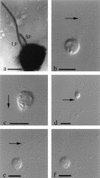Size-selective predation on groundwater bacteria by nanoflagellates in an organic-contaminated aquifer
- PMID: 9464400
- PMCID: PMC106092
- DOI: 10.1128/AEM.64.2.618-625.1998
Size-selective predation on groundwater bacteria by nanoflagellates in an organic-contaminated aquifer
Abstract
Time series incubations were conducted to provide estimates for the size selectivities and rates of protistan grazing that may be occurring in a sandy, contaminated aquifer. The experiments involved four size classes of fluorescently labeled groundwater bacteria (FLB) and 2- to 3-microns-long nanoflagellates, primarily Spumella guttula (Ehrenberg) Kent, that were isolated from contaminated aquifer sediments (Cape Cod, Mass.). The greatest uptake and clearance rates (0.77 bacteria.flagellate-1.h-1 and 1.4 nl.flagellate-1.h-1, respectively) were observed for 0.8- to 1.5-microns-long FLB (0.21-microns3 average cell volume), which represent the fastest growing bacteria within the pore fluids of the contaminated aquifer sediments. The 19:1 to 67:1 volume ratios of nanoflagellate predators to preferred bacterial prey were in the lower end of the range commonly reported for other aquatic habitats. The grazing data suggest that the aquifer nanoflagellates can consume as much as 12 to 74% of the unattached bacterial community in 1 day and are likely to have a substantive effect upon bacterial degradation of organic groundwater contaminants.
Figures


Similar articles
-
Effect of growth conditions and staining procedure upon the subsurface transport and attachment behaviors of a groundwater protist.Appl Environ Microbiol. 2002 Apr;68(4):1872-81. doi: 10.1128/AEM.68.4.1872-1881.2002. Appl Environ Microbiol. 2002. PMID: 11916707 Free PMC article.
-
Effect of flagellates on free-living bacterial abundance in an organically contaminated aquifer.FEMS Microbiol Rev. 1997 Jul;20(3-4):249-59. doi: 10.1111/j.1574-6976.1997.tb00312.x. FEMS Microbiol Rev. 1997. PMID: 9299705
-
Field evidence for a protistan role in an organically-contaminated aquifer.Environ Sci Technol. 2002 Oct 15;36(20):4312-8. doi: 10.1021/es020611m. Environ Sci Technol. 2002. PMID: 12387403
-
Microbial ecology of the terrestrial subsurface.Adv Appl Microbiol. 1988;33:107-72. doi: 10.1016/s0065-2164(08)70206-5. Adv Appl Microbiol. 1988. PMID: 3041739 Review.
-
Natural protection of spring and well drinking water against surface microbial contamination. I. Hydrogeological parameters.Crit Rev Microbiol. 1997;23(2):143-78. doi: 10.3109/10408419709115134. Crit Rev Microbiol. 1997. PMID: 9226112 Review.
Cited by
-
Do Ruminal Ciliates Select Their Preys and Prokaryotic Symbionts?Front Microbiol. 2018 Jul 31;9:1710. doi: 10.3389/fmicb.2018.01710. eCollection 2018. Front Microbiol. 2018. PMID: 30108566 Free PMC article.
-
Internal porosity of mineral coating supports microbial activity in rapid sand filters for groundwater treatment.Appl Environ Microbiol. 2014 Nov;80(22):7010-20. doi: 10.1128/AEM.01959-14. Epub 2014 Sep 5. Appl Environ Microbiol. 2014. PMID: 25192987 Free PMC article.
-
Vertical distribution of the free-living amoeba population in soil under desert shrubs in the Negev desert, Israel.Appl Environ Microbiol. 2005 Apr;71(4):2053-60. doi: 10.1128/AEM.71.4.2053-2060.2005. Appl Environ Microbiol. 2005. PMID: 15812038 Free PMC article.
-
Protistan grazing analysis by flow cytometry using prey labeled by in vivo expression of fluorescent proteins.Appl Environ Microbiol. 2003 Nov;69(11):6848-55. doi: 10.1128/AEM.69.11.6848-6855.2003. Appl Environ Microbiol. 2003. PMID: 14602649 Free PMC article.
-
Microbial exopolymers link predator and prey in a model yeast biofilm system.Microb Ecol. 2006 Aug;52(2):187-97. doi: 10.1007/s00248-006-9063-7. Epub 2006 Aug 8. Microb Ecol. 2006. PMID: 16897306
References
-
- Andersson A, Larsson U, Hagström Å. Size-selective grazing by a microflagellate on pelagic bacteria. Mar Ecol Prog Ser. 1986;33:51–57.
-
- Barcina I, Ayo B, Muela A, Egea L, Iriberri J. Predation rates of flagellate and ciliated protozoa on bacterioplankton in a river. FEMS Microbiol Ecol. 1991;85:141–150.
-
- Beloin R M, Sinclair J L, Ghiorse W C. Distribution and activity of microorganisms in subsurface sediments of a pristine study rate in Oklahoma. Microb Ecol. 1988;16:85–97. - PubMed
Publication types
MeSH terms
LinkOut - more resources
Full Text Sources

